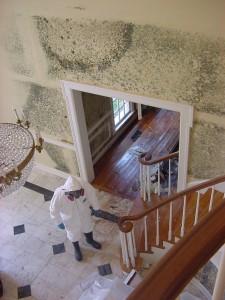Mold know-how: Controlling its growth
November 1, 2013 1:11 pmMold spores are everywhere and cannot be completely removed from residences, but by following common sense and utilizing proper mold know-how, the issues associated with mold growth can be limited. Control the moisture and you will control the mold.
 Rapid response may be obvious when dealing with broken water mains or overflowing clothes washers but it is also critical when dealing with less dramatic water intrusions. Maintenance personnel should be trained in observing possible water sources and signs of damage. Some of these sources and signs include: discoloration of building materials, condensation, rust, improper downspouts and leaking drainpipes. Even though building service workers are equipped to observe the signs and sources of water intrusions, they are not the ones who spend the majority of time in the residences. This distinction belongs to the occupants.
Rapid response may be obvious when dealing with broken water mains or overflowing clothes washers but it is also critical when dealing with less dramatic water intrusions. Maintenance personnel should be trained in observing possible water sources and signs of damage. Some of these sources and signs include: discoloration of building materials, condensation, rust, improper downspouts and leaking drainpipes. Even though building service workers are equipped to observe the signs and sources of water intrusions, they are not the ones who spend the majority of time in the residences. This distinction belongs to the occupants.Residents should be made aware of the importance of reporting water releases as soon as they occur. Management should provide an easy and effective method of tenant communication depending on their unique situation. Not only does it provide the resident with the image of responsible management, but also it provides residents with a reason to report water intrusions.
Remediating mold-impacted surfaces depends on the particular surface it is growing on and the extent of the growth. Hard non-porous surfaces, such as tiles and metal, can be cleaned with a detergent solution wipe and then let to dry. Porous material, such as drywall, may be cleaned depending on the extent of the fungal growth. Superficial growth may be cleaned with the detergent wipe. However, any porous surface where growth is more extensive, wiping with a detergent is not effective. Due to the nature of mold growth, wiping extensive growth only removes the growth on the surface and does not remove the mold that has grown into the material. The growth within the material will eventually reappear, in spite of the thoroughness of the cleaning process. For this reason, removal of the material is necessary.
If the size of the area affected cannot be assessed visually or if the source of musty odors cannot be identified, then a professional testing company should be considered. Whether the work is performed in-house or by a professional company, the area should be visually absent of mold growth after the remediation is complete. Post remediation sampling can provide assurance that the remediation did not produce a worse issue than what was present originally.
